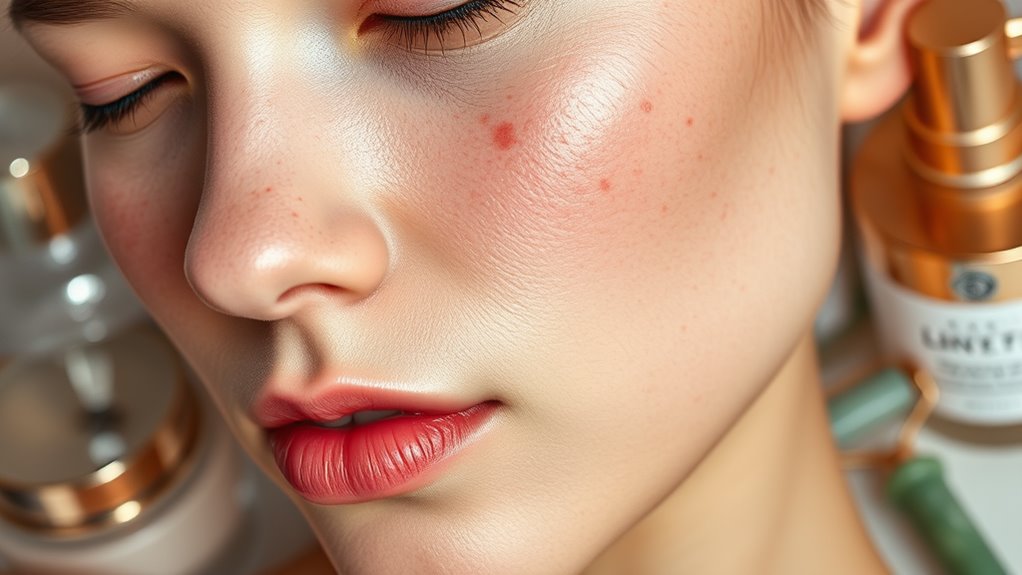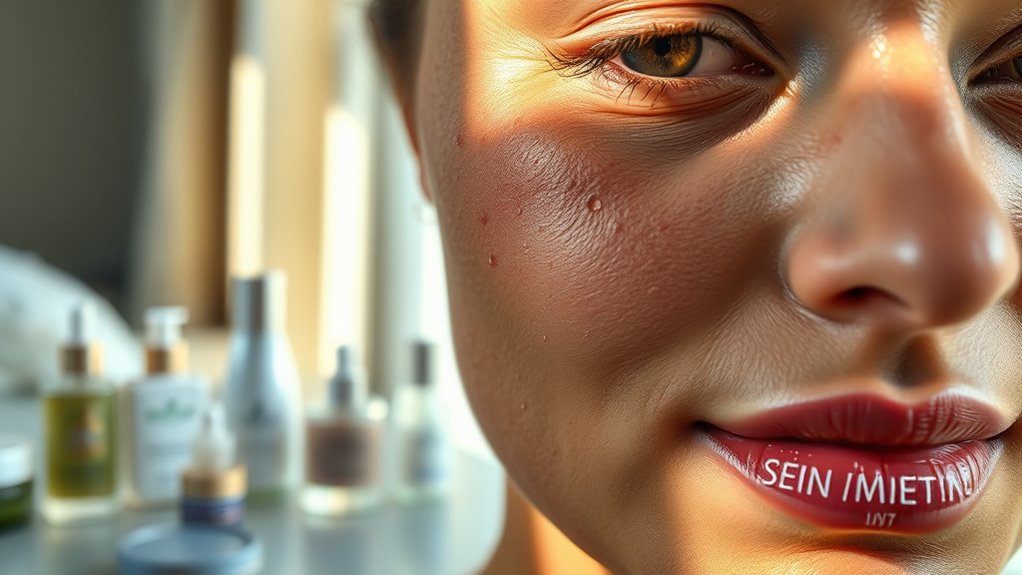Why Your Skin Is Dry and Oily at the Same Time – And How to Fix It Fast
Your skin can be dry and oily at the same time due to hormonal fluctuations, which increase oil production and cause dryness. Environmental factors like climate and pollution also play a role in this imbalance. To fix it fast, use a gentle cleanser, a lightweight moisturizer, and a targeted exfoliant once or twice a week. Track how your skin responds and adjust your routine to restore balance. Discover more strategies for managing combination skin effectively.
Key Takeaways
- Combination skin results from genetics and environmental factors, leading to both dry patches and oily areas, especially in the T-zone.
- Hormonal fluctuations, particularly androgens, can increase oil production, causing imbalances that result in dryness and oiliness.
- Environmental influences like climate extremes and pollution can exacerbate skin imbalances, requiring adjustments in your skincare routine.
- A targeted skincare routine, including gentle cleansing, lightweight moisturizers, and strategic exfoliation, helps manage both dry and oily areas effectively.
- Quick fixes involve using gel-based moisturizers, applying targeted treatments for oily zones, and hydrating serums for dry areas without over-exfoliating.
Understanding Combination Skin: Causes and Symptoms
When you notice dry patches alongside oily areas on your face, you might be experiencing combination skin, a common skin type that can be tricky to manage. This condition arises from various factors, including genetics, environmental influences, and improper skincare routines.
You may find that your T-zone—forehead, nose, and chin—appears shiny, while your cheeks feel parched. Addressing combination skin requires a targeted approach.
For effective dry and oily skin treatment, opt for lightweight, non-comedogenic moisturizers that hydrate without clogging pores. Incorporate gentle exfoliation to remove dead skin cells, and choose a balanced cleanser to maintain your skin’s pH. Understanding combination skin can help you select the right products for your unique needs.
Recognizing these symptoms and implementing precise treatments can help you achieve a harmonious complexion, balancing both dryness and oiliness effectively.
The Role of Hormones in Skin Oil Production
Hormones play a crucial role in regulating skin oil production, as they directly influence the activity of sebaceous glands.
Androgens, particularly testosterone, stimulate these glands, increasing oil production. When your hormone levels fluctuate—due to puberty, menstrual cycles, or stress—you may notice an imbalance, leading to both dryness and excess oil in different areas.
Estrogen, on the other hand, can help maintain skin hydration and control oiliness. If your skin feels both oily and dry, it’s often a sign of hormonal imbalance.
To address this, consider lifestyle changes, such as managing stress, maintaining a balanced diet, and possibly consulting a healthcare professional for hormonal evaluations. Additionally, incorporating natural anti-aging strategies can significantly improve your skin’s overall health.
Understanding your hormones is key to mastering your skin’s needs.
Environmental Factors That Contribute to Skin Imbalance
How do environmental factors impact your skin’s balance? Several external elements can disrupt your skin’s equilibrium, causing it to feel both dry and oily. Understanding these factors is crucial for achieving optimal skin health.
-
Climate: Extreme temperatures, whether hot or cold, can strip moisture or over-stimulate oil production.
-
Pollution: Airborne toxins can clog pores and provoke inflammation, leading to an imbalance in oil and moisture levels.
-
Humidity: Low humidity levels can dehydrate your skin, while high humidity can lead to excess oil production.
Being aware of these environmental influences empowers you to make informed choices in managing your skin. Additionally, adjusting your routine according to seasonal skin care can help maintain your skin’s balance throughout the year.
Effective Skincare Routine for Combination Skin
To effectively manage combination skin, it’s essential to adopt a skincare routine that addresses both dryness and excess oil. Start with a gentle cleanser to remove impurities without stripping moisture. Follow with a lightweight, hydrating toner to balance your skin’s pH. Use a serum rich in antioxidants for nourishment, focusing on drier areas. For moisturizer, choose a non-comedogenic product that hydrates without clogging pores. Lastly, apply sunscreen daily to protect your skin. Additionally, be mindful of common mistakes with tight skin that can exacerbate dryness.
| Step | Morning Routine | Evening Routine |
|---|---|---|
| Cleanser | Gentle foaming cleanser | Creamy hydrating cleanser |
| Toner | Hydrating toner | Exfoliating toner |
| Serum | Antioxidant serum | Repair serum |
| Moisturizer | Lightweight moisturizer | Rich cream |
| Sunscreen | Broad-spectrum sunscreen | – |
Quick Tips for Achieving Balanced Skin Fast
Managing combination skin can be a challenge, but you can achieve balanced skin quickly with a few strategic adjustments. Focus on these three essential tips:
-
Use a gentle exfoliant****: Incorporate a mild exfoliant once or twice a week to remove dead skin cells, promoting even texture and preventing clogged pores. Be cautious, as over-exfoliating your skin can lead to irritation and barrier damage.
-
Select a lightweight moisturizer*: Opt for a *gel-based moisturizer that hydrates without adding excess oil, ensuring your skin stays nourished without feeling greasy.
-
Apply targeted treatments: Use spot treatments for oily areas and hydrating serums for dry patches. This dual approach addresses your skin’s unique needs effectively.




